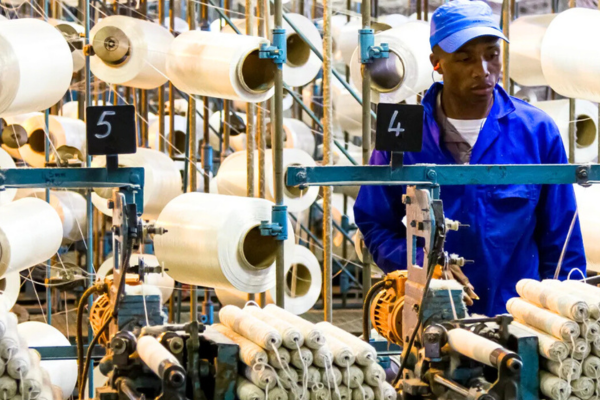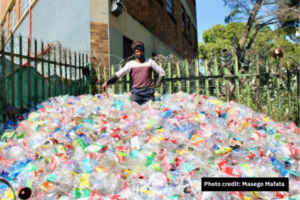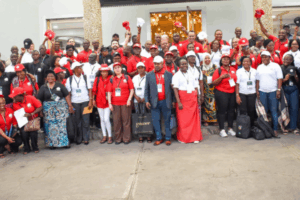In this interview Trenton Elsley, Executive Director of Labour Research Service talks to Etienne Vlok from the South African Clothing and Textile Workers Union (SACTWU) about the link between trade and industrial policy in Africa, specifically within the context of the African Continental Free Trade Area (AfCFTA). Etienne argues that trade policies should be guided by industrial policy to focus on job creation and industrial development.
TRENTON: How do you see the connection between trade and industrial policy, especially in the context of the AfCFTA and its impact on the clothing and textile industry?
ETIENNE: Trade policy should not dictate industrial policy. We need to decide what we want for our economy and manufacturing sector, and then make trade decisions based on that. Let me give you an example. In the 1990s, South Africa rapidly reduced import duties due to WTO commitments. However, there wasn’t a strong industrial policy to support the clothing and textile sector. There was no plan for how factories would cope with reduced duties, increased imports and potential job losses. While reducing duties posed a challenge, the greater issue was the lack of a government plan to help factories modernise, enhance efficiency, and train workers to compete more effectively. This highlights that trade policy cannot lead to industrial policy. There must be a close link between the two, with industrial policy leading the way.
Thinking about the AfCFTA, many countries want to boost their clothing manufacturing, and established players like South Africa are concerned about job losses. What are the prospects for developing regional value chains in Africa and upgrading our place in global value chains?
Many African countries see clothing and textiles as a major opportunity for export and job creation within the AfCFTA. Many countries do not have large chemical, cement, or auto industries so clothing and textiles become a key sector. This means they push to reduce duties on clothing and textiles as much as possible to boost their exports.
Many countries already have significant clothing industries and this has led to regional value chains. For example, Lesotho weaves denim fabric often used in South Africa, and South Africa exports knitted fabric to Eswatini, which is then made into garments for the South African market. It is not necessarily the case that every product will be made in every country, in some cases, production will be focused in certain countries, and for others, value chains will be spread across the continent.
The AfCFTA is both in force and still under negotiation. Can you tell us about the negotiations, particularly around rules of origin in the clothing sector?
When countries enter a trade agreement, they agree to trade certain goods duty-free. But conditions can be placed on this. Rules of origin are conditions on a product. For example, a country might agree to import men’s shirts duty-free, but only if the fabric is woven or knitted in the exporting country or another country that is signatory to the trade agreement. The aim is to ensure that the benefit of trade is not just at the final production stage, but also with the producers of components. This helps create jobs, deepen industrialisation and ensures that countries within the trade area benefit more than those outside.
What is the state of play in AfCFTA negotiations on clothing tariffs?
Negotiations are ongoing, particularly on rules of origin and which products will be shielded from trade liberalisation.
For clothing, there is a general agreement on a two-stage rule of origin, meaning that to export duty-free, the fabric must be woven or knitted in the exporting country or another AfCFTA member country. However, exceptions are being discussed, particularly around synthetic fabrics, as some countries want to import these from outside the continent. A key feature of the AfCFTA is that some products can be shielded from trade liberalisation. These are the products that member states want to protect. Negotiations are ongoing about which products will be protected.
10% of product lines can be shielded with 7% having partial protection and 3% being completely excluded from preferential tariffs. Is this enough to underpin a coherent industrial policy for countries like South Africa, or for less developed neighbours?
This is a complex issue. In this case, it seems that trade policy led the industrial policy. The percentage of goods that could be excluded was decided without enough consideration of the needs of individual countries. We think it should have been higher, perhaps as much as 15%. But now we must work with the decisions that have been made and decide which specific products should be shielded. This means making difficult decisions, such as what must be excluded: tracksuits, sleepwear, baby wear or swimwear? Many African countries do not have a strong local market, and their priority is to export goods. So for them, this issue is not as important as it is for South Africa.
Key takeaways for trade Unions
- Trade agreements must support a country’s industrial development, not the other way around. This is key to protecting jobs and growing the clothing and textile industry.
- The AfCFTA offers opportunities to develop regional value chains. This can lead to more jobs and growth. We must understand these dynamics.
- Rules of Origin are important to ensure that the benefits of trade agreements are felt throughout the manufacturing process and value chain.
- The AfCFTA is still being negotiated, particularly around rules of origin and which products will be protected. We must be aware of these ongoing negotiations and seek to influence them.
- The ability to shield some products from trade liberalisation is crucial for protecting vulnerable industries and jobs. We must continue to demand a seat at AfCFTA national implementing committees and formal social dialogue mechanisms.
Implications for trade unions
Know the products and value chains your members are involved in and how they connect to the AfCFTA.
Advocate for industrial policies that support local manufacturing and create decent jobs.
Demand a voice in trade discussions and the ongoing AfCFTA negotiations. Understand how rules of origin and product shielding work within the AfCFTA and push for rules of origin that protect jobs and promote the development of regional value chains.
Monitor implementation to ensure governments enforce the rules effectively, holding them accountable for customs integrity and trade administration.
Reflect on what has been negotiated thus far and clarify our trade policy orientation and positioning.
RELATED RESOURCES
- A Labour of Love Podcast | Crossing Threads: The Voice of Trade Unions in African Integration
Guest: Etienne Vlok – National Industrial Policy Officer at SACTWU. Listen on Spotify. Watch on YouTube. - A Trade Union Guide to the AfCFTA Protocol on Trade in Goods.








